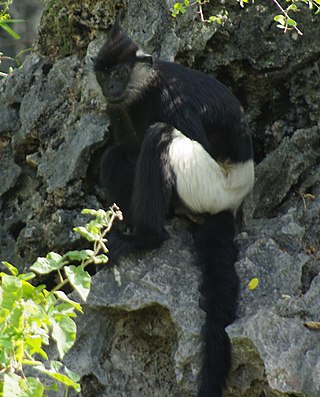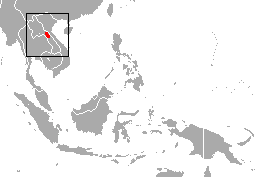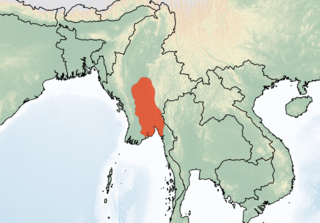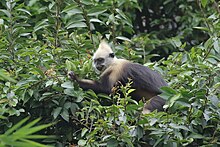
The purple-faced langur, also known as the purple-faced leaf monkey, is a species of Old World monkey that is endemic to Sri Lanka. The animal is a long-tailed arboreal species, identified by a mostly brown appearance, dark face and a very shy nature. The species was once highly prevalent, found in suburban Colombo and the "wet zone" villages, but rapid urbanization has led to a significant decrease in the population level of the monkeys. It had traditionally been classified within the genus Trachypithecus but was moved to the genus Semnopithecus based on DNA evidence indicating that is it more closely related to the gray langurs.

Trachypithecus is a genus of Old World monkeys containing species known as lutungs, langurs, or leaf monkeys. Their range is much of Southeast Asia.

Gee's golden langur, also known as simply the golden langur, is an Old World monkey found in a small region of Western Assam, India and in the neighboring foothills of the Black Mountains of Bhutan. Long considered sacred by many Himalayan people, the golden langur was first brought to the attention of the Western world by the naturalist Edward Pritchard Gee in the 1950s. Adult males have a cream to golden coat with darker flanks while the females and juveniles are lighter. The golden langur has a black face and a long tail up to 50 cm (19.69 in) in length. It lives in high trees and has a herbivorous diet of fruits, leaves, seeds, buds and flowers. The average group size is eight individuals, with a ratio of several females to each adult male. It is one of the most endangered primate species of India and Bhutan.

The Hatinh langur is a highly threatened Old World monkey found in limestone forests in Vietnam, primarily in the Quảng Bình Province. A recent survey discovered a small population living in the Quảng Trị Province. Contrary to its name, it is not known from the Hà Tĩnh Province. The local Van Kieu minority refer to this monkey as the 'Con Cung', which roughly translates as "black, cliff-dwelling monkey with a long tail". It resembles the closely related François' langur, but its white cheek-stripes typically extend behind the ears onto the nape, and the overall black colour is non-glossy and has a brownish tinge.

The silvery lutung, also known as the silvered leaf monkey or the silvery langur, is an Old World monkey. It is arboreal, living in coastal, mangrove, and riverine forests in Peninsular Malaysia, Sumatra, Borneo, Java, and other nearby islands.

The grey-shanked douc langur is a douc species native to the Vietnamese provinces of Quảng Nam, Quảng Ngãi, Bình Định, Kon Tum, and Gia Lai. The total population was estimated at 550 to 700 individuals in 2004. In 2016, Dr. Benjamin Rawson, Country Director of Fauna & Flora International's Vietnam Programme, announced a discovery of an additional population including more than 500 individuals found in Central Vietnam, bringing the total population up to approximately 1000 individuals.

The black-shanked douc is an endangered species of douc found mostly in the forests of Eastern Cambodia, with some smaller populations in Southern Vietnam. The region they are mostly found in is called the Annamite Range, a mountainous area that passes through Cambodia and Vietnam. Its habitat is mostly characterized by evergreen forest in the mountains, in the middle to upper canopy. They move around quadrupedally and by brachiation up in the trees. This species is unique with its coloration among the doucs as it has a bluish face with yellow rings around its eyes a blue scrotum and a pink penis. Like other doucs, this specie has a tail as long as its body and head length. Black-shanked douc have been observed in groups ranging from 3 to 30 individuals, depending on their habitat. Group tend to have a fission-fusion dynamic that changes with food availability. Their diet varies from dry to wet season. Regardless of the season, their diet consists mostly of leaves, but they have also been found to consume considerable amounts of fruits and flowers during wet season. The species changed conservation status in 2015 from endangered to critically endangered in the IUCN Red List of Endangered Species. This reassessment is due to an increase of the rate of population decline. No global population estimate exists. The majority of the population can be found in Cambodia, with smaller populations in Vietnam. In fact, the Wildlife Conservation Society reports almost 25,000 individuals in Cambodia's Keo Seima Wildlife Sanctuary, a population that has remained stable over the last decade. The largest populations estimated to be in Vietnam is around 500-600 individuals. The biggest challenges that the black-shanked douc faces in terms of conservation are habitat loss and illegal poaching. Conservation efforts are being made to control illegal poaching and trade in Vietnam by putting laws against hunting and trading threatened species.

Delacour's langur or Delacour's lutung is a critically endangered species of Old World monkey endemic to northern Vietnam. It is named for French-American ornithologist Jean Théodore Delacour.

François' langur, also known as Francois' leaf monkey, the Tonkin leaf monkey, or the white side-burned black langur is a species of Old World monkey and the type species of its species group. It is one of the least studied of the species belonging to the Colobinae subfamily.

The Cat Ba langur, also known as the golden-headed langur, is a critically endangered species of langur endemic to Cát Bà Island, Vietnam. It is among the rarest primates in the world, and possibly the rarest primate in Asia, with population size estimated at less than 70 individuals.

Phayre's leaf monkey, also known as Phayre's langur, is a species of Old World monkey native to South Asia and Southeast Asia, namely India, Bangladesh, and Myanmar. Populations from further east are now thought to belong to other species. It is listed as Endangered on the IUCN Red List and is threatened by hunting and loss of habitat. The species epithet commemorates Arthur Purves Phayre.

The Raffles' banded langur, also known as the banded leaf monkey or banded surili, is a species of primate in the family Cercopithecidae. It is endemic to Singapore and southern Peninsular Malaysia. The species underwent taxonomic revisions in 2019 and 2020, in which two former subspecies were elevated to separate species. As a result, the Raffles' banded langur meets the criteria for being listed as critically endangered by the IUCN. It is mainly threatened by habitat loss.

The Laotian langur or white-browed black langur is a species of primate in the family Cercopithecidae. It is endemic to Laos. Its natural habitat is subtropical or tropical dry forests. Genetically the Indochinese black and Hatinh langurs are very close to the Laotian langur, and consequently it has been suggested they should be considered subspecies of it.

Germain's langur is an Old World monkey native to Thailand, Myanmar, Cambodia, Laos and Vietnam. The monkey was previously included in Trachypithecus cristatus and Trachypithecus villosus.
The Indochinese black langur is a poorly known Old World monkey native to Laos and adjacent Vietnam. It was originally described as a subspecies of T. auratus, but was later found to be a member of the T. francoisi group, with some maintaining it as a subspecies of that species. In 2001, it was recommended treating it as a separate species.

The World's 25 Most Endangered Primates is a list of highly endangered primate species selected and published by the International Union for Conservation of Nature (IUCN) Species Survival Commission (SSC) Primate Specialist Group (PSG), the International Primatological Society (IPS), Global Wildlife Conservation (GWC), and Bristol Zoological Society (BZS). The IUCN/SSC PSG worked with Conservation International (CI) to start the list in 2000, but in 2002, during the 19th Congress of the International Primatological Society, primatologists reviewed and debated the list, resulting in the 2002–2004 revision and the endorsement of the IPS. The publication was a joint project between the three conservation organizations until the 2012–2014 list when BZS was added as a publisher. The 2018–2020 list was the first time Conservation International was not among the publishers, replaced instead by GWC. The list has been revised every two years following the biannual Congress of the IPS. Starting with the 2004–2006 report, the title changed to "Primates in Peril: The World's 25 Most Endangered Primates". That same year, the list began to provide information about each species, including their conservation status and the threats they face in the wild. The species text is written in collaboration with experts from the field, with 60 people contributing to the 2006–2008 report and 85 people contributing to the 2008–2010 report. The 2004–2006 and 2006–2008 reports were published in the IUCN/SSC PSG journal Primate Conservation,, since then they have been published as independent publications.

Many areas of Vietnam are under protection. While the national reserves cover small areas of scientific significance with restricted access, the national parks also cover wetlands of Ramsar designated areas and BirdLife International inscribed bird areas. The largest of the national parks initially covered were the Cúc Phương National Park, the Cát Tiên National Park, and the Côn Đảo National Park which to start with were forest areas cum reserves or prohibited areas. The objective for creating national parks was to allow access to the reserved areas as a part of ecotourism and cultural needs with full attention to the basic approach of conservation of natural environmental resources.

The Jiang Nan subtropical evergreen forests ecoregion covers the mountainous divide between the lower Yangtze River and the coastal plain of South China. The region is also a climatic divide between the temperate valleys of the north and the subtropical forests of the south. The region is important for biodiversity and endemic species. The rugged limestone karst hills have been relatively protected from conversion to agriculture, and support specialized plant and animal communities.

The Popa langur is a species of primate in the family Cercopithecidae. It occurs only in Myanmar and was named after Mount Popa, where a population of 100 of the monkeys live. It is listed as Critically Endangered on the IUCN Red List, as the wild population is thought to comprise 200 to 250 mature individuals.

The Indochinese grey langur is a species of Old World monkey native to East and Southeast Asia.




















